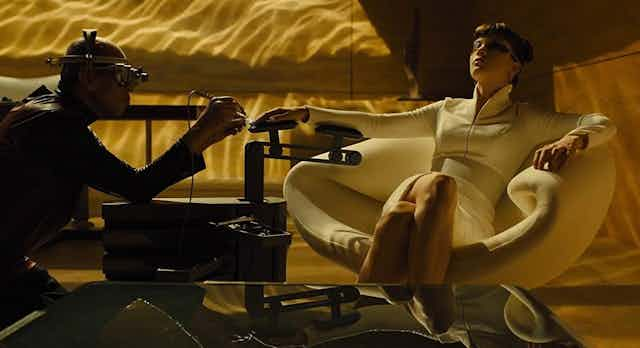Science fiction is brimming with visions of the future and the many wondrous things the human race can achieve. But it is full of warnings too – and we should be careful to take heed of some of the big messages that are more relevant now than they ever were before.
Robots and AI
Ever since the word “robot” first appeared in the English language in the early 1920s (although it was invented by a Czech writer), science fiction writers have warned about the blurring of the distinction between human and machine.
Robots are becoming more and more like humans, such that it may one day become difficult to tell the two apart. But were they ever really so different? Philip K. Dick suggests possibly not, and his vision of replicants in Do Androids Dream of Electric Sheep? (1968) – which was to become a classic movie, Blade Runner – certainly poses a lot of important questions.
It’s not just robots we have to worry about these days. AI is now perhaps an even bigger threat than its robot cousins. From the ominous HAL 9000 in Arthur C. Clarke’s 2001: A Space Odyssey (1968), to the “benevolent” AI character Mike in Robert A. Heinlein’s The Moon is a Harsh Mistress (1966), we’ve been warned that the power of AI to infiltrate every aspect of our daily lives might one day prove our undoing – and we will have no one to blame but ourselves.
Threats from the great beyond
Science fiction is brimming with invasion narratives, the most famous of which is probably H.G. Wells’ classic The War of the Worlds. Wells’ novel, which first appeared in 1898, has since been adapted into numerous films, TV shows and even a musical.
Of course, many of these narratives tie in with fears about invasions of one kind of another closer to home, with swarming insects or “bugs” used in place of the alien “other”, such as in Heinlein’s classic novel Starship Troopers (1959) and its film adaptation (1997).
But while the invaders of Starship Troopers may stir visions of the Cold War (a common theme – see Invasion of the Body Snatchers as well), perhaps the biggest threat raised by the likes of Wells, Heinlein and the rest is the threat of the enemy not yet known. It may be comforting to think of enemy invaders as mindless hordes, or ravenous beasts, but these depictions are far too simplistic and are designed to appeal to our base emotions.
The human condition
Of all the threats confronting the human race, the biggest challenge is by far and a way posed by ourselves. From short-termism and mistaken priorities, to evil corporations shaping the way we think (see: The Space Merchants [1952]), so many science fiction authors draw attention to the many varied failings of the human condition and our often misguided attempts to “do good”.
Expanding to the stars may well solve some of our nearer-term issues such as climate change, overpopulation and a scarcity of resources, but a bigger threat is posed by the fact we are all too likely to take our problems with us and that we will repeat the same mistakes time and time again.
Science vs nature
Despite its name, science fiction has, for many years now, been much closer to science fact. While science fiction writers such as Heinlein, Isaac Asimov and Frederik Pohl dreamed of instant communications and a world of knowledge at our fingertips, the future has now well and truly crashed in on the present and we live in a time now where it’s harder than ever to tell truth and fiction apart.
But while some readers might think this a positive thing on the whole (you are, after all, reading this online), science fiction has much to say about overconfidence and the misplaced faith we have in our ability to harness science and use our powers for good.
In Flowers for Algernon (1966), a man of low intelligence is transformed into a genius, only to discover a flaw in the experiment that will see him regress to a far worse situation that he started out in. While the story focuses on the rise and fall of a genius, it also reveals a lack of human compassion in the scientists and a lack of understanding for just where their actions may lead.
If we want to use science to conquer nature, we need to be circumspect in how we go about it. Progress for the sake of progress is not always a good thing – and we need to be wary of short-termism and guard against complacency in all we do.
Distorted reality
Of course, one of the most chilling aspects of science fiction working its way into our modern-day world is the way reality is becoming distorted, and it becomes increasingly hard to tell truth from fiction.
In this age of consumer culture, social media and fake news, the work of Philip K. Dick is more relevant than ever before, and we should take heed of his warning in books such as Ubik (1969) and The Three Stigmata of Palmer Eldritch (1965), about the dangers of getting sucked into fake realities – many of which we create ourselves (see: social media). Such is the timeliness and relevance of Dick’s work, that his novels continue to provide much material for screenwriters, from the recent TV series The Man in the High Castle (2015) to the critically-acclaimed Blade Runner: 2049 (2017).
All of these musings lead us to wonder, what do we mean by “real” anyway? Dick may not come to any solid conclusions, but he does show us how we are shaped by the world around us. Unless we come to understand our relationship with the world – and our place in it – there is little hope left to be had.

